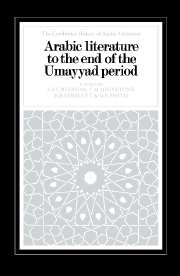Book contents
- Frontmatter
- Contents
- Editorial introduction
- 1 The tribes of pre-Islamic Arabia
- 2 The Umayyad Empire, c. A.D. 750
- 1 Background topics
- 2 Pre-Islamic poetry
- 3 Early Arabic prose
- 4 The beginnings of Arabic prose literature: the epistolary genre
- 5 The role of parallelism in Arabic prose
- 6 The Qur'ān-I
- 7 The Qur'ān–II
- 8 Qiṣaṣ elements in the Qur'ān
- 9 Aspects of the Qur'ān today
- 10 Ḥadīth literature–I: The development of the science of Ḥadīth
- 11 Ḥadīth literature-II: Collection and transmission of Ḥadīth
- 12 Shī'ī Ḥadīth
- 13 Narrative elements in the Ḥadīth literature
- 14 European criticism of Ḥadīth literature
- 15 The impact of the Qur'ān and Ḥadīth on medieval Arabic literature
- 16 The Maghāzī literature
- 17 The Sīrah literature
- 18 The poetry of the Sīrah literature
- 19 Fables and legends in pre-Islamic and early Islamic times
- 20 Umayyad poetry
- 21 Music and verse
- 22 The Greek impact on Arabic literature
- 23 The Persian impact on Arabic literature
- 24 The Syrian impact on Arabic literature
- Appendix Bibliography of translations of the Qur'ān into European languages
- Glossary
- List of sources
- Index
21 - Music and verse
Published online by Cambridge University Press: 28 May 2012
- Frontmatter
- Contents
- Editorial introduction
- 1 The tribes of pre-Islamic Arabia
- 2 The Umayyad Empire, c. A.D. 750
- 1 Background topics
- 2 Pre-Islamic poetry
- 3 Early Arabic prose
- 4 The beginnings of Arabic prose literature: the epistolary genre
- 5 The role of parallelism in Arabic prose
- 6 The Qur'ān-I
- 7 The Qur'ān–II
- 8 Qiṣaṣ elements in the Qur'ān
- 9 Aspects of the Qur'ān today
- 10 Ḥadīth literature–I: The development of the science of Ḥadīth
- 11 Ḥadīth literature-II: Collection and transmission of Ḥadīth
- 12 Shī'ī Ḥadīth
- 13 Narrative elements in the Ḥadīth literature
- 14 European criticism of Ḥadīth literature
- 15 The impact of the Qur'ān and Ḥadīth on medieval Arabic literature
- 16 The Maghāzī literature
- 17 The Sīrah literature
- 18 The poetry of the Sīrah literature
- 19 Fables and legends in pre-Islamic and early Islamic times
- 20 Umayyad poetry
- 21 Music and verse
- 22 The Greek impact on Arabic literature
- 23 The Persian impact on Arabic literature
- 24 The Syrian impact on Arabic literature
- Appendix Bibliography of translations of the Qur'ān into European languages
- Glossary
- List of sources
- Index
Summary
Apart from its intrinsic interest, the relationship between music and verse is of particular concern because of the often-mooted possibility that music (and musicians) may have made a significant contribution to the developments that took place in Hijazi poetry during the first/seventh century. But the nature of the relationship is not easy to define with any precision, and some of the problems it raises are singularly intractable. In effect, early Arabic poetry and music differ radically as objects of scholarly enquiry, essentially because there is nothing in music comparable to the extensive corpus of poetry that has been preserved. The first specimen of notation that may be thought to provide a reasonably accurate account of a song as realized in performance dates from as late as c. 700/1300, represents a seventh/thirteenth-century composition, and is moreover a unique example.
To re-create the early musical idiom from the limited materials available is quite impossible. One might suggest as a literary parallel an attempted reconstruction of early poetry from much later forms based on a consideration of such diverse sources as the critical remarks of al-Jāhiz and Ibn Qutaybah, the biographies of poets in the Kitāb al-Aghānī (the “Book of Songs”, a famous fourth/tenth-century work by al-Isfahānī), and one or two technical treatises on prosody and rhetoric – but with all the examples of poetry removed. Broadly speaking, discussions of music tend towards either the theoretical (culminating in abstractions sometimes of questionable relevance to practice) or, when dealing with the performer and his milieu, the sociological.
- Type
- Chapter
- Information
- Arabic Literature to the End of the Umayyad Period , pp. 433 - 459Publisher: Cambridge University PressPrint publication year: 1983
- 22
- Cited by



